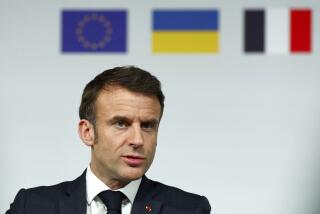Immigrants Change Face of Old Europe
- Share via
A demographic revolution is changing the face of Europe. Declining birthrates, coupled with growing immigration, mean the end of ethnic homogeneity for Europe’s traditional nation-states. Also, Europe’s predominantly Christian population must get used to the idea of intermixing with Muslims; with immigrants flowing in from Turkey, North Africa and the Middle East, mosques and halal butchers are taking their place alongside cathedrals and charcuteries.
Integrating minorities into European society is perhaps the single most important challenge facing the European Union.
Multiethnic society does not come easily to Europe. Until recent reforms, Germany defined citizenship through ethnicity rather than birthplace or residency, leaving, say, German-born Turks without a true sense of belonging. France has long embraced a more inclusive notion of citizenship, but many French continue to distinguish between citizens of French stock (francais de souche) and others.
This mind-set has contributed to widespread ethnic segregation, with minority communities in European countries regularly living in their own enclaves -- often impoverished and feeling like second-class citizens.
The resulting social strains have buoyed the political fortunes of Europe’s anti-immigrant right.
In France’s last presidential election, Jean-Marie Le Pen, long an icon of the extreme right, garnered almost 20% of the vote, besting the incumbent prime minister in the first round before losing to Jacques Chirac in a runoff.
Before the 2002 elections in Holland, Pim Fortuyn was one of the first Dutch politicians to openly discuss the need to preserve traditional Dutch values and norms in the face of immigration. Fortuyn’s popularity soared -- but his political career was cut short by an assassin just before the vote.
The Austrian elections of 1999 brought into the governing coalition the Freedom Party of Jorg Haider, a politician well known for his racist attitudes. Although Haider has stepped down as party leader -- in part because of the international uproar resulting from his electoral success -- his party is still in the ruling coalition.
However appealing the exclusionary impulse of the far right seems, Europeans cannot afford to close their doors to newcomers. Without immigration, the population of most European countries is poised to age and shrink. Europe’s fertility rate is well below what’s needed to keep the population at its current level. Today, there are 35 pensioners for every 100 workers within the European Union. By 2050, current demographic trends would leave Europe with 75 pensioners for every 100 workers, and in countries like Italy and Spain, the ratio would be 1 to 1.
Like it or not, Europe will have to turn to immigration for its economic survival.
Europe’s proximity to North Africa and Turkey -- as well as the youth bulge in many Islamic countries -- will ensure a steady inflow of Muslim immigrants.
The European Union is already home to about 15 million Muslims, and this number is expected to double by 2015. About 5 million Muslims live in France alone. Although at least one-half of France’s Muslims are French citizens, the community as a whole has been growing more radicalized. A sense of social isolation (many Muslims live in urban ghettos) and of disenfranchisement (there is not a single Muslim in the National Assembly) has been fueling a mounting and angry Islamic fervor.
In an effort to dampen rising social tensions, the French National Assembly recently passed a bill prohibiting Muslim girls from wearing headscarves in public schools. Indeed, all conspicuous religious symbols, including yarmulkes and large crosses, were prohibited. The legislation was intended to protect schoolgirls who preferred not to wear a hajib -- many were being coerced to don headscarves by radicalized groups. It was also meant to preserve a secularized public domain, a priority for France ever since the legislated separation of church and state in 1905. It remains to be seen whether France’s Muslims -- about 50% opposed the ban -- come to see it as a positive step toward integration or an unwanted infringement on their religious freedom.
Whether or not prohibiting religious symbols from the classroom succeeds in promoting tolerance and integration, France and its neighbors need to work much harder at building communities that are multiethnic in spirit as well as fact. Integrating minority communities into the social mainstream means ensuring that they have ready access to language classes, civics courses and job training. Without education and social mobility, minority groups are destined to remain alienated and disaffected.
European governments must also do a better job of combating prejudice and promoting tolerance among their majority populations. At stake is not just the viability of multiethnic community in Europe but also Europe’s ability to remain one of the globe’s centers of liberal democracy and economic vitality.
Charles A. Kupchan, a professor of international affairs at Georgetown University, is a senior fellow at the Council on Foreign Relations.
More to Read
Sign up for Essential California
The most important California stories and recommendations in your inbox every morning.
You may occasionally receive promotional content from the Los Angeles Times.










